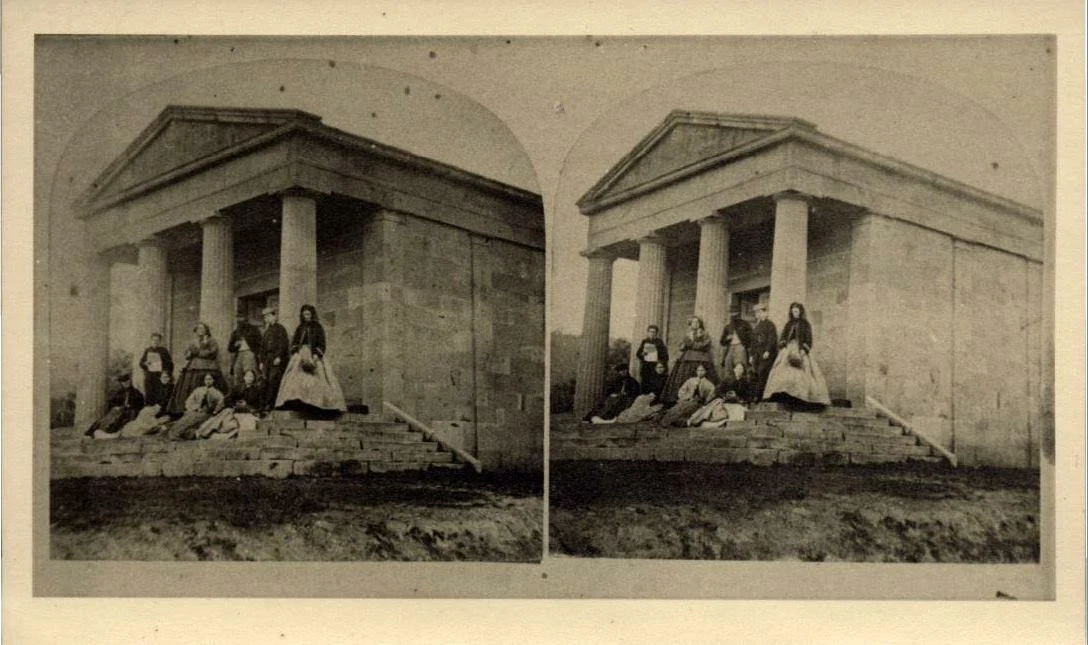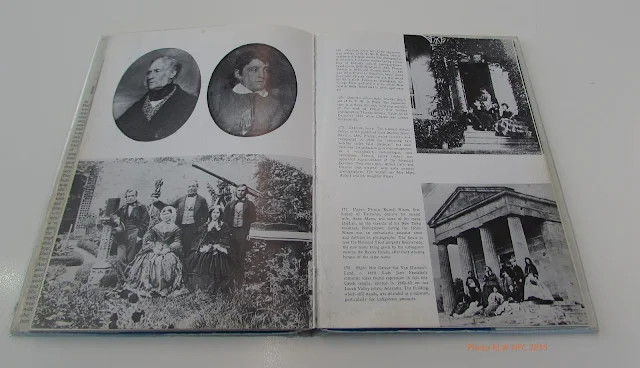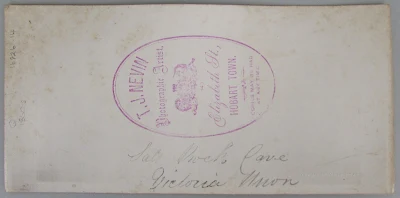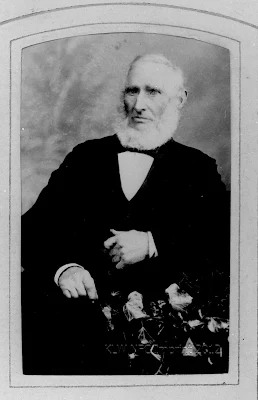George CHARLTON, prison records, aliases and monikers
SIMS' Excelsior coal mine, Kangaroo Valley, Hobart, Tasmania
The Mugshot
Prisoner George Charlton, photographed by T. J. Nevin, Hobart Gaol, September 1874.

Prisoner CHARLTON, George
TMAG Ref: Q15571
Photographer: Thomas J. Nevin
Date and Location: Hobart Gaol, September 1874.
The numbering on recto "58" was applied in 1983 when this cdv was removed from the Queen Victoria Museum and Art Gallery (QVMAG), Launceston, together with another three hundred or more 1870s mugshots taken at the Hobart Gaol by government contractor Thomas J. Nevin which were acquired by the QVMAG as part of the bequest from the estate of convictarian John Watt Beattie in the 1930s. When they were removed from Beattie's collection and taken down to the Port Arthur prison heritage site for an exhibition as part of the Port Arthur Conservation Project in 1983, they were not returned to the QVMAG. They were deposited instead at the TMAG where this cdv is currently held .

Verso of cdv of prisoner CHARLTON, George
TMAG Ref: Q15571
Photographer: Thomas J. Nevin
Date and Location: Hobart Gaol, September 1874.
The verso information is incorrect. George Charlton was not photographed at the Port Arthur prison in 1874, he was photographed in the week ending 14th September 1874 on discharge from the Hobart Gaol by government contractor and professional photographer Thomas J. Nevin.
Police and Court Records
George Charlton aliases, monikers and misspellings:
George Charletan, Geordie, John Scott, George Chilton

6th July 1844
Convict transport Blundell arrived Hobart 6 July 1844
Charlton, George
Record Type: Convicts
Ship: Blundell
Place of origin: Newcastle upon Tyne, Northumberland
Origin location: Latitude and Longitude
Voyage number: 365
Index number: 11912
Record ID: NAME_INDEXES:1380271
3rd June 1858
Charlton, George
Record Type: Court
Status: Ticket of leave
Trial date: 3 Jun 1858
Place of trial: Hobart town
Offense: Burglary in the dwelling of Martha Wilcox with intent to steal
Verdict: Guilty
Prosecutions Project ID: 100095
Record ID: NAME_INDEXES:1504770
31st January 1868
TRANSCRIPTS
HAMILTON.-On the 29th instant, by J. F. Sharland, Esquire,
J.P., for the arrest of George Charletan [sic], per Blundell,
charged with house-breaking, and stealing £26 (since
recovered) the moneys of Mrs. Smith, Ouse.
Description.
50 or 52 years old, 5 feet 1 or 2 inches high , brown to
grey hair, light complexion, bald, wore a new black
billy-cock hat, brown vest (new), old brownish trousers,
striped jumper, and blucher boots, slight made, a miner,
an Englishman. He is likely to make for the coal
mines at New Town, where he formerly worked. He
was convicted 10 years ago for a similar offence at Mrs.
Williams's. See Crime Report of the 27th October, 1865,
page 174, prisoners discharged.( Tasmania Reports of Crime, 31 Jan 1868, p. 16)
14th February 1868
Vide Crime Report of the 31st ultimo, page 16. Referring to George Charletan charged with housebreaking, &c. He is likely to get on one of the crafts trading from Hobart Town to the Huon. He is known as Geordie. A Reward is offered for his arrest if effected within two months from the 5th instant.(Tasmania Reports of Crime, 14 Feb 1868, p. 24)
7th August 1868
MISCELLANEOUS INFORMATION.
Vide Crime Report of the 31st January 1868, page 16.
Referring to George Charletan charged with housebreaking, he left the service of Mr. Kermode about a month ago, having been employed as cook to the Mechanics under the name of John Scott. He wore Bedford-cord trousers and a long blackcoat. Was heard of at Campbell Town about a fortnight ago. (Tasmania Reports of Crime, 7 Aug 1868, p. 124)
14th August 1868
Vide Crime Report of the 31st January, 14th February, and the 7th instant, pages 16, 25, and 124. George Charletan has been arrested by Sub-Inspector Stevens, of the Campbell Town Municipal Police. Vide Crime Report of the 17th April, 1868, page 60. (Tasmania Reports of Crime, 7 Aug 1868, p. 128)15th September 1868
Trial id: 110237
Name: GEORGE CHARLTON
Sex of offender: MALE
First offence for which indicted: LARCENY IN A DWELLING HOUSE
Date of trial: 1868-09-15
Location of trial: HOBART TOWN
Judge: FLEMING
Verdict first offence: GUILTY
Sentence: 8 YEARS
Source: Prosecution Project
https://prosecutionproject.griffith.edu.au/
Conduct register - Port Arthur
Item Number:CON94/1/1
Start Date:01 Jan 1868
End Date:31 Dec 1869
Source: Archives Office Tasmania Ref: CON94-1-1_00004_L
George Charlton's name was misspelt as CHILTON, George per Blundell (folio 6) on this index to the Conduct Register, Port Arthur, 1868-1869, though correct on his record of payments while serving time at the Port Arthur prison, arriving there on 30th September 1868, sentenced to eight years, discharged on 14 September 1874.

George Charlton, CON94-1-1 Image 29
Conduct register - Port Arthur
Item Number:CON94/1/1
Start Date:01 Jan 1868
End Date:31 Dec 1869
Source: Archives Office Tasmania
16th October 1877
TRANSCRIPT:
GLENORCHY POLICE COURT.-Mr. Harry Gordon writes complaining that in our report of the last sitting of the Police Court at Glenorchy, a man named Charlton, charged with using bad language, was described as being a lodger in his house. Mr. Gordon says that he does not keep a lodging-house, and that Charlton was a farm servant employed by him.Source: The Mercury (Hobart, Tas.) Tue 16 Oct 1877 Page 2
Coal Mines at New Town (Tasmania)
George Charlton had worked in the New Town coal mines in the 1860s, located at Kangaroo Valley, Hobart (now Lenah Valley), Tasmania, and was thought to make his way there again when he was sought for housebreaking and stealing at Ouse in January 1868. He may well have encountered Thomas J. Nevin in the vicinity while acting as guide and photographer for visiting tourist groups to the Lady Franklin Museum.
TRANSCRIPT:
HAMILTON.-On the 29th instant, by J. F. Sharland, Esquire,
J.P., for the arrest of George Charletan [sic], per Blundell,
charged with house-breaking, and stealing £26 (since
recovered) the moneys of Mrs. Smith, Ouse.
Description.
50 or 52 years old, 5 feet 1 or 2 inches high , brown to
grey hair, light complexion, bald, wore a new black
billy-cock hat, brown vest (new), old brownish trousers,
striped jumper, and blucher boots, slight made, a miner,
an Englishman. He is likely to make for the coal
mines at New Town, where he formerly worked. He
was convicted 10 years ago for a similar offence at Mrs.
Williams's. See Crime Report of the 27th October, 1865,
page 174, prisoners discharged.
Source: Tasmania Reports of Crime for Police
31st January 1868, p.16
Sims' Excelsior Coal Mine
Thomas J. Nevin offered more than just photographic services from his studio at 140 Elizabeth St. Hobart from 1868 to 1876 while operating as both a commercial photographer and government contractor. He organised events on the social committees of the Benevolent Society and the Loyal Odd Fellow's Lodge, and acted as the city agent for several businesses such as Sim's Excelsior Coal Mine, Kangaroo Valley, New Town . He took orders at his studio for coal deliveries from Messrs Sims and Stops' mine which was located not far from the family house built by his father John Nevin on land in trust to the Wesleyan church in 1854 adjacent to the Lady Franklin Museum. A lengthy geological report was published on Christmas Day in the Mercury, 25 December 1883 (p. 3) - (see Addendum below), on the coal mines and seams around kunanyi/Mt Wellington, including a description of the methods of mining at Mr Ebenezer Sim's Excelsior Coal Mine and an account of the formation of anthracite, shale and sandstone in the Kangaroo Valley area.
This photograph of the horse-drawn whim working the coal mine at Sim's Excelsior Coal Mine, Kangaroo Valley, New Town, was taken by Thomas J. Nevin in the late 1860s. He printed it as a stereograph on an arched buff mount.

Detail: single image of double image stereograph
Horse-drawn whim at Mr Sim's Excelsior Coal Mine, Kangaroo Valley, New Town, Tasmania
Stereograph on arched buff mount by Thomas J. Nevin, 1870s
"Thos Nevin New Town" studio stamp on verso
Tasmanian Museum and Art Gallery Collection. TMAG Ref: Q16826.11


Verso: Horse-drawn whim at Mr Sim's Excelsior Coal Mine, Kangaroo Valley, New Town, Tasmania
Stereograph on arched buff mount by Thomas J. Nevin, 1870s
"Thos Nevin New Town" studio stamp on verso
Tasmanian Museum and Art Gallery Collection
TMAG Ref: Q16826.11
Addendum
Extract from the report on carboniferous deposits in New Town near Hobart, Tasmania by the Inspector of Mines and Geological Surveyor, G. THUREAU, F.O.S., published in the Mercury, Christmas Day, Tuesday 25 December 1883, page 3:

TRANSCRIPT
THE CARBONIFEROUS DEPOSITS NEAR NEW TOWN.Source: THE CARBONIFEROUS DEPOSITS NEAR NEW TOWN. (1883, December 25). The Mercury p. 3.
The following report has just been issued from the Government Printing office :-
These occur at the north-eastern slopes of the spurs or foot-hills descending from Mount Wellington, and therefore within the western parts of New Town.
As the question whether the diamond drill could be recommended to be beneficially employed in that locality formed the principal part of my instructions, an extensive surface examination has been made in order to ascertain, from the lithological and palaeontological character of the carbonaceous strata and that of the contained seams of coal* whether boring to greater depths could possibly give good results or otherwise.
It is deemed necessary, before going any further, to give a few particulars as to the principal coal-yielding mines, in order to be able to refer to same in the following portions of this report.
Mr. Tim. Meredith's mine is worked by means of a horse-whim and a shaft 200ft. deep from the surface, in which the second seam of this district was intersected at 195ft. ; the coal varies from 1ft. 3in. to 2ft. 6in. in thickness, and is subjected to numerous faults and jumps, rendering it some-times difficult to recover the faulted or missing continuations of this seam. The main fault observes a bearing of south 67 deg. east, and a nearly parallel fault close by, south 40 deg. east. The coal is of a better quality generally at this greater depth than any other, as it is disposed of at from 22s. to 25s. per ton. Five men and a whim-boy are employed at this private mine.
-----------
* The word coal, continued throughout this report, though, as it is explained, it is not really the coal as known to consumers.
-----------
The Enterprise Coal Mining Co. (private) is the only one that employs steam winding machinery for working their mine. Their shaft is 110ft. in depth, and they are also working the second seam from the top, which averages 22in. of useful coal, the seam itself, with a parting of shale or "clod," being 2ft. 10in. thick. In the direction of the dip of the coal, or south 44 deg. west, they have extended their workings to a distance of 200yds., thus following the best description of the coal : and their experience has been that, towards Hobart, as exemplified in the adjacent Jarvis and Old Rosetta mines - now abandoned - the seams become very disordered, and that towards the south rises considerably and gets much thinner and therefore unremunerative. In following that seam from the shaft along its dip, the subterranean water follows the workings as they in-cline in that direction, necessitating the employment of an underground force-pump to permit the coal hewers to work. Fifteen to 17,000 gallons of water are raised daily from this mine, and the cost of cutting the coal is at the rate of 8s. per ton, fetching 22s. in the market.
Mr. Ebenezer Sims' coal mine, adjoining the last named, is wrought by means of a horse-whim. The coal occurs at 65ft., and at 70ft. or 80ft. below that measuring 18in. in thickness. From the upper seam, which is about 2ft. 6in. thick, 16 tons are raised by five miners per week on the average, which are sold on the " bank" at 7s. per ton, and at 22s. if delivered to consumers at their houses. The average dip is in the same direction as last, at the rate of 6in to the yard, indicating either a fault or other disturbance between this and the Enterprise Co.'s shafts. The coal in its undulating dip has been found quite irregular, "clumpy," and of but little value if inclining to the south-east ; there is also a considerable influx of water per diem, at the rate of from 18,000gals. to 20,000gals.
The region, in the near neighbourhood of the above described coal mines, now working or abandoned, presents some remarkable features, directly due to the close vicinity of "vents" of volcanic rocks, and the actual protrusion of dense basaltic dykes through the formations carrying the coal. The results of the penetration of the coal measures by these volcanic vents and dykes appear to have led to and caused, in the first instance, the conversion of the pre-existent true coal measures into carbonaceous shales and sand-stones, and of the seams of coal into "Anthracites."
As regards the former, they are of considerable thickness, as seen on the top of the New Town-road near the old tollgate ; their lower series exhibit occasionally very thin veins of black carbon-non-bituminous. The embedded seams, belonging also to the series of converted coals, -i.e., anthracites, -presents the usual appearance of black vitreous to half metallic and iridescent lustre, with a black streak ; they are not easily ignited, but burn with an evolution of great heat, very little smoke and smell, leaving residues after burning almost the same in bulk as the raw mineral itself before, combustion. They are non-bituminous, forming a natural stratified and compact, coke as the result of contact with and in the vicinity of igneous rocks. With an admixture of other suitable fuel they are very useful for the production of quicklime, and for smelting raw iron ores for rough cast-iron.
I did not succeed in observing or collecting any paleontological specimens of any kind.
The New Town anthracites, occurring in close contiguity to Mount Wellington, the extinct ' crater or centre of stupendous volcanic action, lose their character as such whenever they approach any of those more recent eruptive igneous rocks. It appears that from this great centre of pre-historic upheavals and convulsions, the adjacent or overlying strata was shattered and disrupted by fissures radiating from the former, and those clefts were filled with volcanic matter which converted not only the coal measures and scams of coal as described, but caused likewise many faults and other irregularities.
As a matter of fact the New Town carboniferous deposit may be regarded as the lower series or the remnants of coal measures that were altered or transmuted into non-bituminous deposits by the action of under-lying volcanic rocks or of analogous dykes traversing the country. Under these circumstances the permanency of the present seams of anthracite depend on the more or less frequent intrusion of those dykes, and consequently, as the latter occur at uncertain and irregular intervals and places, the output of this mineral is also subjected to the same... [etc etc - end of extract]
G. THUREAU, F.O.S.,
Inspector of Mines and Geological Surveyor.
Link:https://nla.gov.au/nla.news-article9013224
RELATED POSTS main weblog
- Nevin's coal mine stereograph for Messrs Sims and Stops
- Views and portraits for the Lands & Survey Department
- Rogues Gallery: Tasmanian Museum and Art Gallery Collection



































